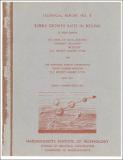| dc.contributor.author | Griffith, P. | en_US |
| dc.contributor.other | Massachusetts Institute of Technology. Division of Industrial Cooperation. DIC Project no. 5-7348. | en_US |
| dc.contributor.other | Massachusetts Institute of Technology. Division of Industrial Cooperation. DIC Project no. 5-7374. | en_US |
| dc.date.accessioned | 2011-03-04T23:31:46Z | |
| dc.date.available | 2011-03-04T23:31:46Z | |
| dc.date.issued | 1956 | en_US |
| dc.identifier | 15186922 | en_US |
| dc.identifier.uri | http://hdl.handle.net/1721.1/61464 | |
| dc.description.abstract | The conditions determining the growth rate of a bubble on a surface in boiling are considered and a mathematical model framed in the light of these conditions. The growth rate is then calculated for bubbles growing under a range of conditions of pressure, wall superheat and bulk fluid temperature. The average growth rate of a bubble is found to decrease with increasing maximum size' and to decrease with increasing pressure. At high pressure the maximum size of the bubble is found to be independent of pressure and primarily a function of the thickness of the superheated layer near the surface. The calculated bubble growth velocities are then used to correlate some burnout data for a variety of fluids under a range of pressures in pool boiling. Bubble growth pictures are presented for water at atmospheric pressure under a variety of conditions. | en_US |
| dc.description.sponsorship | Office of Naval Research Contract D.I.C. Project National Science Foundation Grant | en_US |
| dc.format.extent | [38] leaves in various pagings (some unnumbered) | en_US |
| dc.publisher | Cambridge, Mass. : Massachusetts Institute of Technology, Division of Industrial Cooperation, [1956] | en_US |
| dc.relation.ispartofseries | Technical report (Massachusetts Institute of Technology, Heat Transfer Laboratory) ; no. 8. | en_US |
| dc.subject | Bubbles. | en_US |
| dc.title | Bubble growth rates in boiling | en_US |
| dc.type | Technical Report | en_US |
